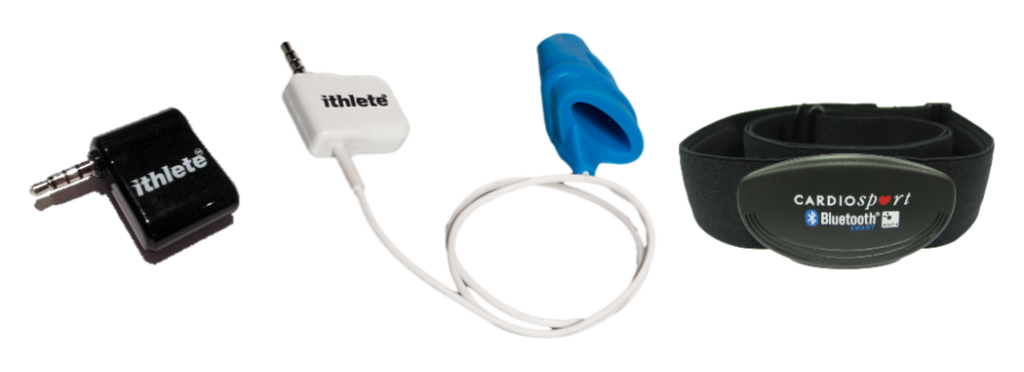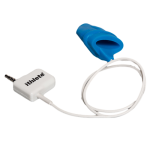There are many great reasons to choose ithlete, so many that we’ve written a blog series looking at why we do things the way we do. Follow the series to learn more about the type and length of measurement, how breathing influences your HRV and much more.
The different sensors
Whilst scientific validity and accuracy remain the centre of everything we do here at ithlete we realise not everyone wants the same thing. This, and understanding that only a small number of people were prepared to put on a strap first thing every morning, meant we knew we must provide sensor options.
Using the same science as hospital pulse monitors, the ithlete Finger sensor is the most convenient way to measure heart rate variability. The next option is a Bluetooth Smart HRM strap, of which many of the leading models are compatible. Finally, you could use the ECG set up, which requires a small ECG Receiver to plug in to your phone and works with a Polar style analogue chest strap.
The story of increased HRV usage is largely one of improved convenience. We previously looked at how HRV was first measured, and it’s certainly not something you would want to do at home, let alone every morning. Although modern HRM chest straps are really quite accurate compared to the EKG gold standard, the need to keep the strap in really good condition and moisten the strap contacts with (salty) water before taking an HRV reading mean that it’s also not the most convenient way to start the day.
For this reason, and the rise of the fitness wearables industry, over the past few years there has been new interest in light based sensors (called photoplethsymographs or PPG for short) for everyday consumer applications. PPGs have been used in hospitals for many years, and generally employ infra-red light shining through, or green light reflecting off, the skin. As ever, though there is no free lunch, and the convenience comes with potential inaccuracy caused by even small amounts of motion, or poor blood circulation in the skin. This potential inaccuracy of wearables has sometimes even hit the headlines, such as the Fitbit case summarised here.
The most convenient sensor
With nothing suitable available, in 2012 we decided to develop our own. Modelled closely on the sensors used in hospitals, we wanted to produce a sensor that was convenient and affordable, yet accurate enough for HRV. As part of the all-important convenience requirement, we wanted to avoid batteries and chargers (who says ‘oh good, another accessory charger that I need to take with me’?). We also had to ensure that the sensor worked first time without complex pairing procedures. So we used a cable connection instead of Bluetooth which can sometimes be tricky. That’s why we used the phone headset socket. You can get the small amount of power required to light up the infra-red LED directly, eliminating the need for batteries. You also get the very accurate signal processing capabilities of the smartphone meaning you can update the sensor software via the app when improvements in this fast-evolving world become available.
Since 2012, the ithlete finger sensor has become the most validated design of its type, and is now used in studies around the world, some in the harshest of environments.
Using a Bluetooth HRM strap
Whilst ithlete does support any Bluetooth connected sensor that sends individual heartbeat (R-R) intervals, you do need to be careful, as some of these are just not accurate enough for HRV measures. If you’re not sure whether the watch / armband / sensor you have is suitable, do a Google search for the make and model, together with the words ‘HRV’ and ‘validation’. If the manufacturer states the product to be accurate for HRV, they should be able to reference at least one independent study that states this. Models that we know work well include the Cardiosport Blue, Polar H6/7/10, Wahoo Tickr, Suunto Smart Belt.
The problem with Garmin ANT+ HRM straps
Some users express frustration that ithlete is not compatible with Garmin HRM straps. However, there is a good reason for this, Garmin wasn’t able to agree with phone manufacturers to include the ANT+ transmission standard. So, for ithlete, or any other app for that matter, a Garmin strap cannot talk to it directly. The Cardiosport strap that we sell is able to work via Bluetooth or ANT+ and so is universally compatible – we only wish Garmin would also provide a universal sensor.
If you are unsure, or would like to update your existing sensor then the ithlete Finger Sensor is undoubtedly the most convenient and user friendly option!

Garmin now make a dual MRM that is ANT+ and Bluetooth
That’s great to know, thanks Robert! If anyone has tested it with ithlete we’d love to hear from you.
Best, Laura